BUS300: Competitive Strategy Tools and Their Business Applications
VerifiedAdded on 2021/06/14
|9
|1845
|48
Essay
AI Summary
This essay provides an in-depth analysis of three critical tools used in competitive strategy: SWOT analysis, the Five Forces framework, and the Resource-Based View (RBV). The essay begins by explaining the SWOT analysis, its components (Strengths, Weaknesses, Opportunities, and Threats), and how companies like McDonald's utilize it to assess internal and external factors for strategic planning. Next, it delves into the Five Forces model, developed by Michael Porter, illustrating how it helps businesses evaluate industry attractiveness by examining competitive rivalry, the threat of substitutes, new entrants, and the bargaining power of suppliers and buyers, with Qantas Airways as an example. Finally, the essay explores the RBV model, highlighting how companies identify and leverage their unique resources, focusing on the VRIO framework (Value, Rarity, Imitability, and Organization), to achieve a competitive advantage, using Zara as a case study. The essay concludes by emphasizing the importance of these tools in a dynamic business environment, enabling companies to develop effective strategies for sustained growth and profitability. These tools aid businesses in analyzing market trends and formulating effective business strategies for long-term success. The essay uses real-world examples to clarify the application of each model, thus providing a comprehensive understanding of competitive strategy development. These concepts are crucial for any student studying business or related fields.
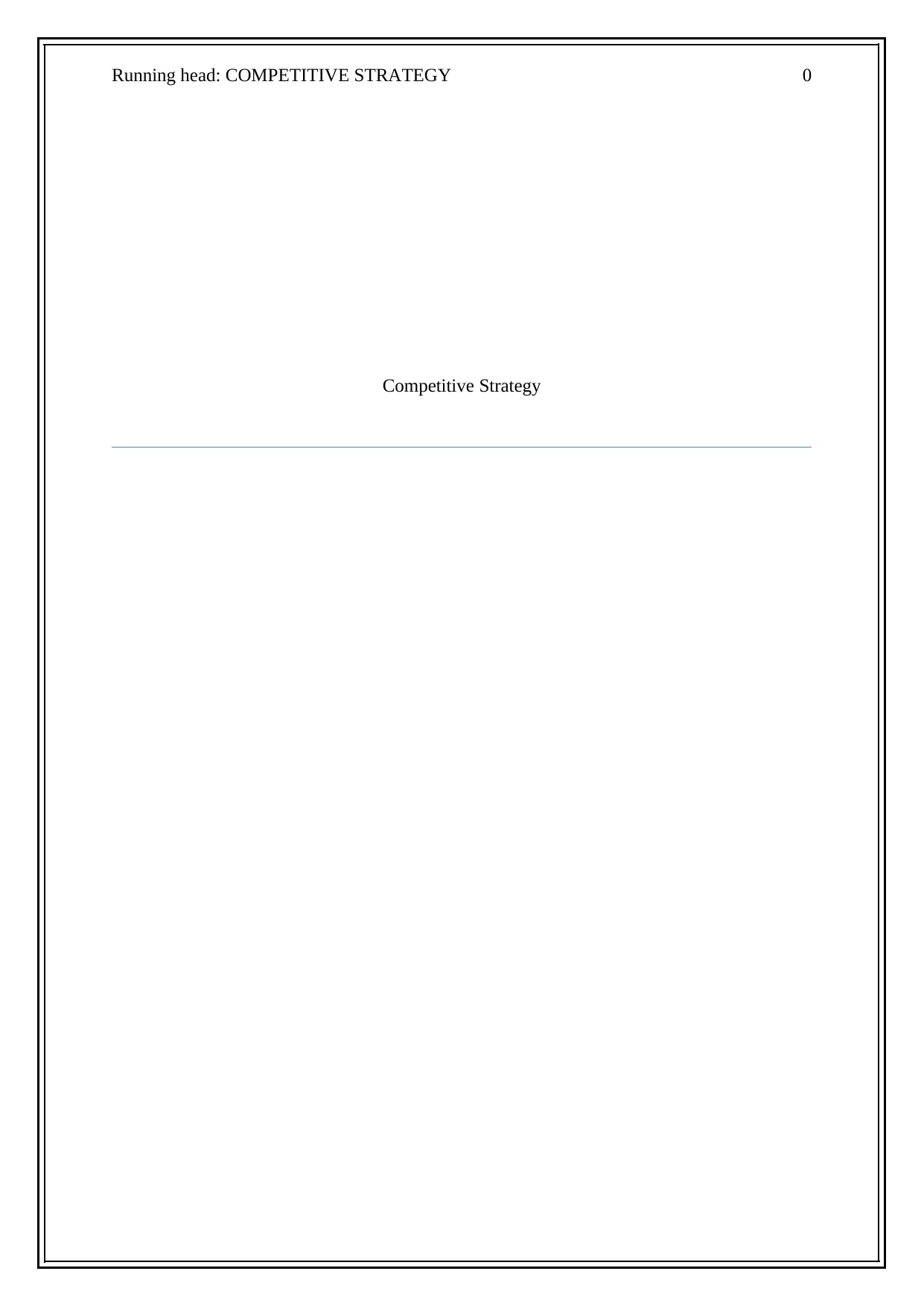
Running head: COMPETITIVE STRATEGY 0
Competitive Strategy
Competitive Strategy
Paraphrase This Document
Need a fresh take? Get an instant paraphrase of this document with our AI Paraphraser
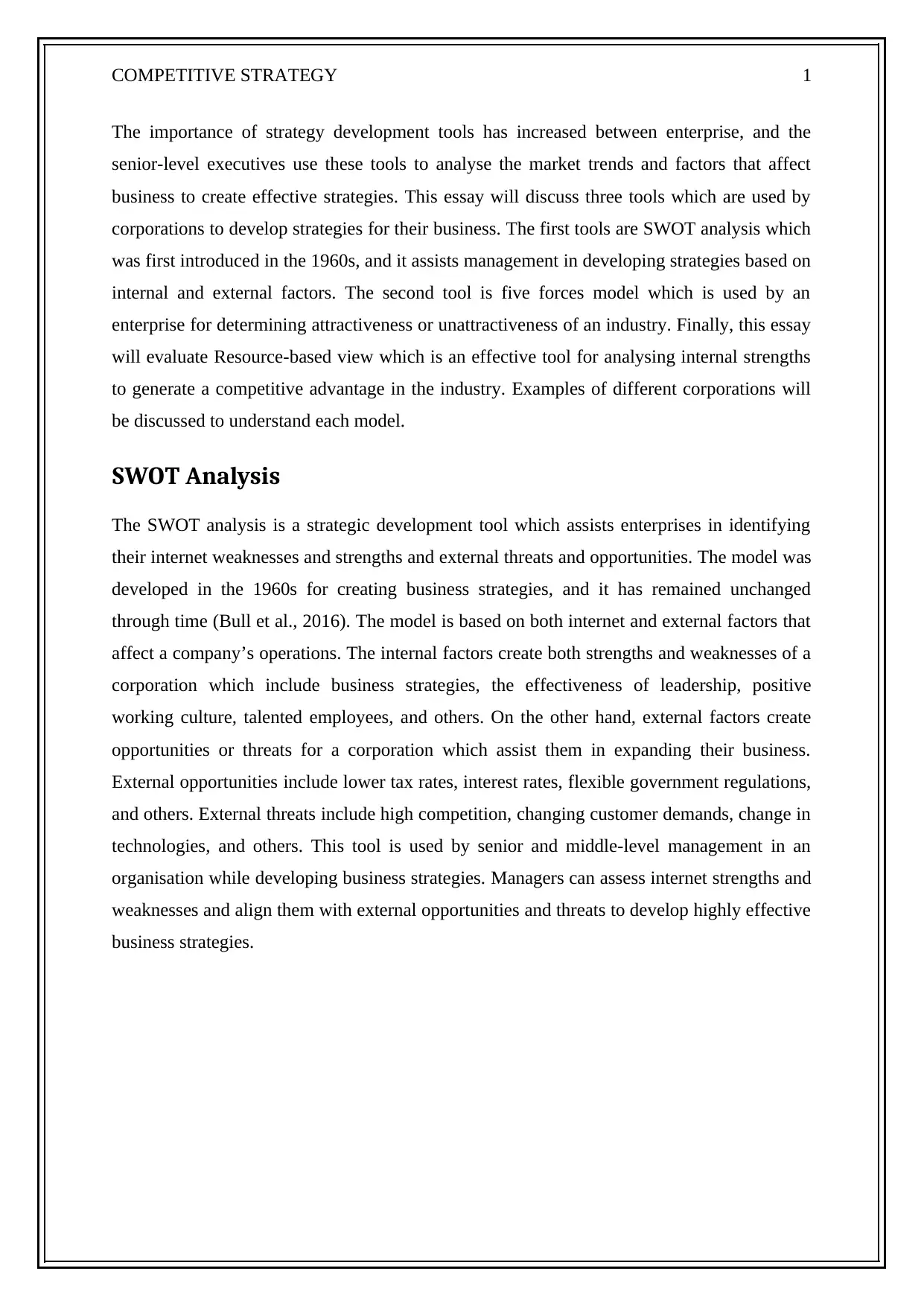
COMPETITIVE STRATEGY 1
The importance of strategy development tools has increased between enterprise, and the
senior-level executives use these tools to analyse the market trends and factors that affect
business to create effective strategies. This essay will discuss three tools which are used by
corporations to develop strategies for their business. The first tools are SWOT analysis which
was first introduced in the 1960s, and it assists management in developing strategies based on
internal and external factors. The second tool is five forces model which is used by an
enterprise for determining attractiveness or unattractiveness of an industry. Finally, this essay
will evaluate Resource-based view which is an effective tool for analysing internal strengths
to generate a competitive advantage in the industry. Examples of different corporations will
be discussed to understand each model.
SWOT Analysis
The SWOT analysis is a strategic development tool which assists enterprises in identifying
their internet weaknesses and strengths and external threats and opportunities. The model was
developed in the 1960s for creating business strategies, and it has remained unchanged
through time (Bull et al., 2016). The model is based on both internet and external factors that
affect a company’s operations. The internal factors create both strengths and weaknesses of a
corporation which include business strategies, the effectiveness of leadership, positive
working culture, talented employees, and others. On the other hand, external factors create
opportunities or threats for a corporation which assist them in expanding their business.
External opportunities include lower tax rates, interest rates, flexible government regulations,
and others. External threats include high competition, changing customer demands, change in
technologies, and others. This tool is used by senior and middle-level management in an
organisation while developing business strategies. Managers can assess internet strengths and
weaknesses and align them with external opportunities and threats to develop highly effective
business strategies.
The importance of strategy development tools has increased between enterprise, and the
senior-level executives use these tools to analyse the market trends and factors that affect
business to create effective strategies. This essay will discuss three tools which are used by
corporations to develop strategies for their business. The first tools are SWOT analysis which
was first introduced in the 1960s, and it assists management in developing strategies based on
internal and external factors. The second tool is five forces model which is used by an
enterprise for determining attractiveness or unattractiveness of an industry. Finally, this essay
will evaluate Resource-based view which is an effective tool for analysing internal strengths
to generate a competitive advantage in the industry. Examples of different corporations will
be discussed to understand each model.
SWOT Analysis
The SWOT analysis is a strategic development tool which assists enterprises in identifying
their internet weaknesses and strengths and external threats and opportunities. The model was
developed in the 1960s for creating business strategies, and it has remained unchanged
through time (Bull et al., 2016). The model is based on both internet and external factors that
affect a company’s operations. The internal factors create both strengths and weaknesses of a
corporation which include business strategies, the effectiveness of leadership, positive
working culture, talented employees, and others. On the other hand, external factors create
opportunities or threats for a corporation which assist them in expanding their business.
External opportunities include lower tax rates, interest rates, flexible government regulations,
and others. External threats include high competition, changing customer demands, change in
technologies, and others. This tool is used by senior and middle-level management in an
organisation while developing business strategies. Managers can assess internet strengths and
weaknesses and align them with external opportunities and threats to develop highly effective
business strategies.
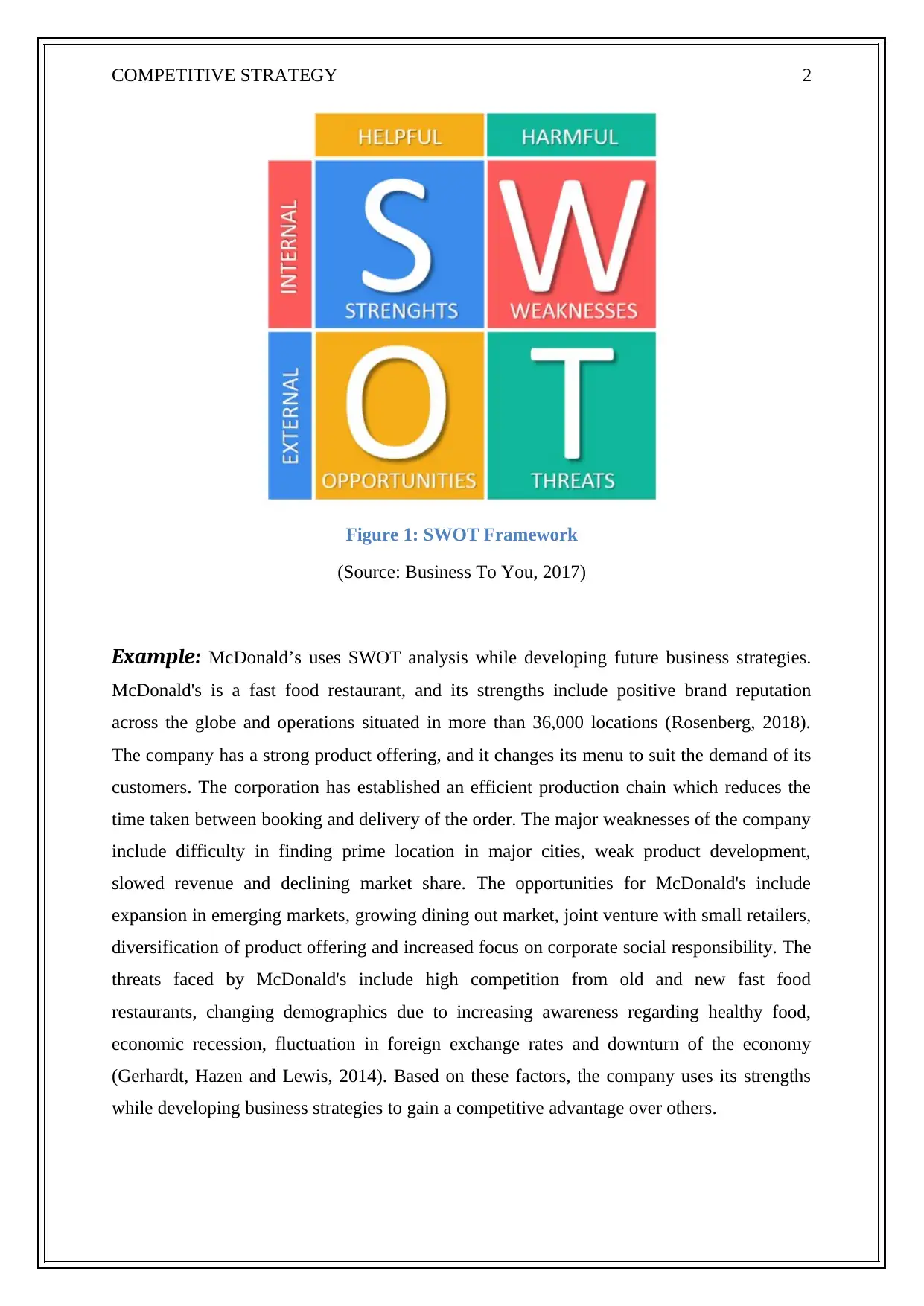
COMPETITIVE STRATEGY 2
Figure 1: SWOT Framework
(Source: Business To You, 2017)
Example: McDonald’s uses SWOT analysis while developing future business strategies.
McDonald's is a fast food restaurant, and its strengths include positive brand reputation
across the globe and operations situated in more than 36,000 locations (Rosenberg, 2018).
The company has a strong product offering, and it changes its menu to suit the demand of its
customers. The corporation has established an efficient production chain which reduces the
time taken between booking and delivery of the order. The major weaknesses of the company
include difficulty in finding prime location in major cities, weak product development,
slowed revenue and declining market share. The opportunities for McDonald's include
expansion in emerging markets, growing dining out market, joint venture with small retailers,
diversification of product offering and increased focus on corporate social responsibility. The
threats faced by McDonald's include high competition from old and new fast food
restaurants, changing demographics due to increasing awareness regarding healthy food,
economic recession, fluctuation in foreign exchange rates and downturn of the economy
(Gerhardt, Hazen and Lewis, 2014). Based on these factors, the company uses its strengths
while developing business strategies to gain a competitive advantage over others.
Figure 1: SWOT Framework
(Source: Business To You, 2017)
Example: McDonald’s uses SWOT analysis while developing future business strategies.
McDonald's is a fast food restaurant, and its strengths include positive brand reputation
across the globe and operations situated in more than 36,000 locations (Rosenberg, 2018).
The company has a strong product offering, and it changes its menu to suit the demand of its
customers. The corporation has established an efficient production chain which reduces the
time taken between booking and delivery of the order. The major weaknesses of the company
include difficulty in finding prime location in major cities, weak product development,
slowed revenue and declining market share. The opportunities for McDonald's include
expansion in emerging markets, growing dining out market, joint venture with small retailers,
diversification of product offering and increased focus on corporate social responsibility. The
threats faced by McDonald's include high competition from old and new fast food
restaurants, changing demographics due to increasing awareness regarding healthy food,
economic recession, fluctuation in foreign exchange rates and downturn of the economy
(Gerhardt, Hazen and Lewis, 2014). Based on these factors, the company uses its strengths
while developing business strategies to gain a competitive advantage over others.
⊘ This is a preview!⊘
Do you want full access?
Subscribe today to unlock all pages.

Trusted by 1+ million students worldwide
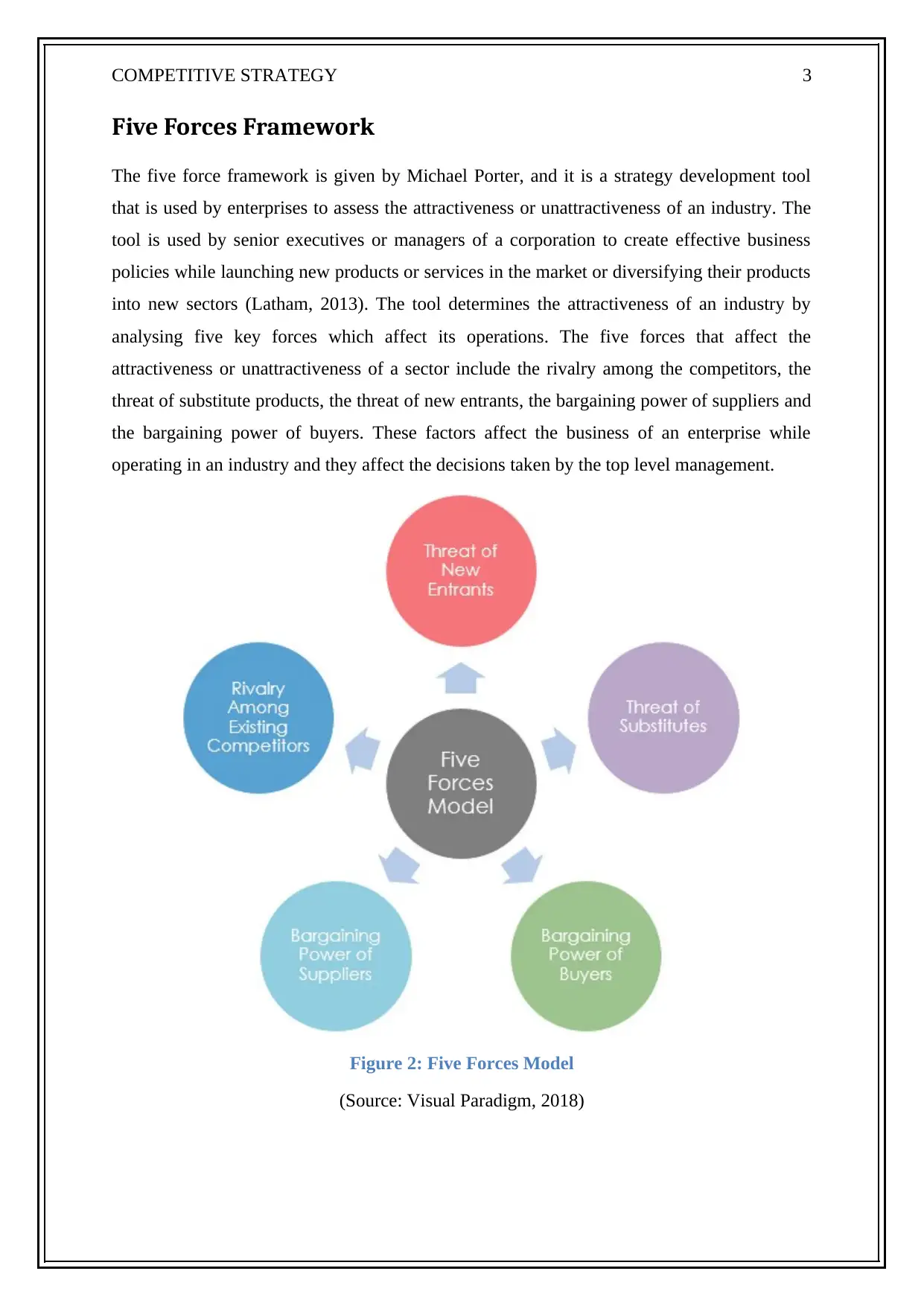
COMPETITIVE STRATEGY 3
Five Forces Framework
The five force framework is given by Michael Porter, and it is a strategy development tool
that is used by enterprises to assess the attractiveness or unattractiveness of an industry. The
tool is used by senior executives or managers of a corporation to create effective business
policies while launching new products or services in the market or diversifying their products
into new sectors (Latham, 2013). The tool determines the attractiveness of an industry by
analysing five key forces which affect its operations. The five forces that affect the
attractiveness or unattractiveness of a sector include the rivalry among the competitors, the
threat of substitute products, the threat of new entrants, the bargaining power of suppliers and
the bargaining power of buyers. These factors affect the business of an enterprise while
operating in an industry and they affect the decisions taken by the top level management.
Figure 2: Five Forces Model
(Source: Visual Paradigm, 2018)
Five Forces Framework
The five force framework is given by Michael Porter, and it is a strategy development tool
that is used by enterprises to assess the attractiveness or unattractiveness of an industry. The
tool is used by senior executives or managers of a corporation to create effective business
policies while launching new products or services in the market or diversifying their products
into new sectors (Latham, 2013). The tool determines the attractiveness of an industry by
analysing five key forces which affect its operations. The five forces that affect the
attractiveness or unattractiveness of a sector include the rivalry among the competitors, the
threat of substitute products, the threat of new entrants, the bargaining power of suppliers and
the bargaining power of buyers. These factors affect the business of an enterprise while
operating in an industry and they affect the decisions taken by the top level management.
Figure 2: Five Forces Model
(Source: Visual Paradigm, 2018)
Paraphrase This Document
Need a fresh take? Get an instant paraphrase of this document with our AI Paraphraser

COMPETITIVE STRATEGY 4
Example: Qantas Airways is an Australian Airline company which was founded in 1921.
The company operates in the aerospace industry, and it offers its services across the globe.
The competitive rivalry in the industry is high because a large number of domestic and
international airlines operate in the industry. Large international airlines such as Delta, United
and Emirates have increased competition for local Australian airlines. The bargaining power
of suppliers is high in the industry because Boeing and Airbus are two main aircraft suppliers
and they can hike up the prices of aircraft because they supply to airlines across the globe
(Forsyth and Stewart, 2012). The bargaining power of buyers is high because a large number
airline operates in the industry and with the increase in low-cost airlines the competition
between airline operators has increased. Furthermore, the popularity of third-party online
ticket booking services has increased the bargaining power of buyers because they can easily
compare between airline prices. The threat of new entrants is low because of strict
government conditions and requirement of high initial investment (Homsombat, Lei and Fu,
2014). The threat of substitute is low because air travel is the faster way of travelling in local
and international markets. Alternative options include train, bus, ship or cars which are slow
and relatively uncomfortable options.
Resource-based View (RBV)
Resource-based view model is used by enterprises to identify their resources which can
provide them a competitive advantage over their competitors. This model is used by senior
level management while creating future business policies for maintaining or sustaining their
competitive advantage (Hunt and Davis, 2012). Resources which show the characteristics of
VRIO model are used by the enterprises for generating a competitive advantage. VRIO is an
acronym for value, rarity, imitability and organisation. This model analyses whether a
resource is valuable, rare, inimitable and organised by the company which assist in
generating a competitive advantage for the enterprise.
Example: Qantas Airways is an Australian Airline company which was founded in 1921.
The company operates in the aerospace industry, and it offers its services across the globe.
The competitive rivalry in the industry is high because a large number of domestic and
international airlines operate in the industry. Large international airlines such as Delta, United
and Emirates have increased competition for local Australian airlines. The bargaining power
of suppliers is high in the industry because Boeing and Airbus are two main aircraft suppliers
and they can hike up the prices of aircraft because they supply to airlines across the globe
(Forsyth and Stewart, 2012). The bargaining power of buyers is high because a large number
airline operates in the industry and with the increase in low-cost airlines the competition
between airline operators has increased. Furthermore, the popularity of third-party online
ticket booking services has increased the bargaining power of buyers because they can easily
compare between airline prices. The threat of new entrants is low because of strict
government conditions and requirement of high initial investment (Homsombat, Lei and Fu,
2014). The threat of substitute is low because air travel is the faster way of travelling in local
and international markets. Alternative options include train, bus, ship or cars which are slow
and relatively uncomfortable options.
Resource-based View (RBV)
Resource-based view model is used by enterprises to identify their resources which can
provide them a competitive advantage over their competitors. This model is used by senior
level management while creating future business policies for maintaining or sustaining their
competitive advantage (Hunt and Davis, 2012). Resources which show the characteristics of
VRIO model are used by the enterprises for generating a competitive advantage. VRIO is an
acronym for value, rarity, imitability and organisation. This model analyses whether a
resource is valuable, rare, inimitable and organised by the company which assist in
generating a competitive advantage for the enterprise.
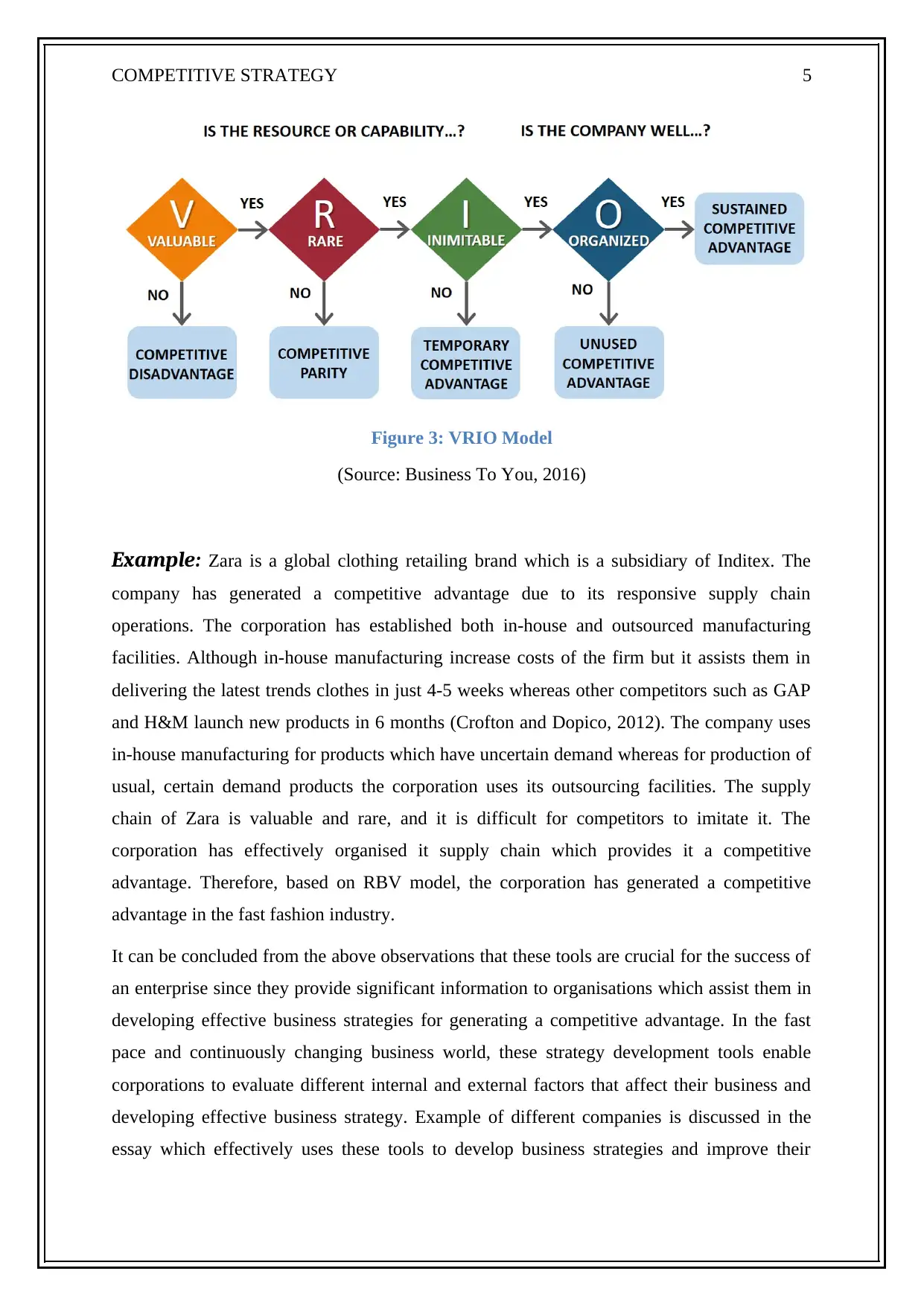
COMPETITIVE STRATEGY 5
Figure 3: VRIO Model
(Source: Business To You, 2016)
Example: Zara is a global clothing retailing brand which is a subsidiary of Inditex. The
company has generated a competitive advantage due to its responsive supply chain
operations. The corporation has established both in-house and outsourced manufacturing
facilities. Although in-house manufacturing increase costs of the firm but it assists them in
delivering the latest trends clothes in just 4-5 weeks whereas other competitors such as GAP
and H&M launch new products in 6 months (Crofton and Dopico, 2012). The company uses
in-house manufacturing for products which have uncertain demand whereas for production of
usual, certain demand products the corporation uses its outsourcing facilities. The supply
chain of Zara is valuable and rare, and it is difficult for competitors to imitate it. The
corporation has effectively organised it supply chain which provides it a competitive
advantage. Therefore, based on RBV model, the corporation has generated a competitive
advantage in the fast fashion industry.
It can be concluded from the above observations that these tools are crucial for the success of
an enterprise since they provide significant information to organisations which assist them in
developing effective business strategies for generating a competitive advantage. In the fast
pace and continuously changing business world, these strategy development tools enable
corporations to evaluate different internal and external factors that affect their business and
developing effective business strategy. Example of different companies is discussed in the
essay which effectively uses these tools to develop business strategies and improve their
Figure 3: VRIO Model
(Source: Business To You, 2016)
Example: Zara is a global clothing retailing brand which is a subsidiary of Inditex. The
company has generated a competitive advantage due to its responsive supply chain
operations. The corporation has established both in-house and outsourced manufacturing
facilities. Although in-house manufacturing increase costs of the firm but it assists them in
delivering the latest trends clothes in just 4-5 weeks whereas other competitors such as GAP
and H&M launch new products in 6 months (Crofton and Dopico, 2012). The company uses
in-house manufacturing for products which have uncertain demand whereas for production of
usual, certain demand products the corporation uses its outsourcing facilities. The supply
chain of Zara is valuable and rare, and it is difficult for competitors to imitate it. The
corporation has effectively organised it supply chain which provides it a competitive
advantage. Therefore, based on RBV model, the corporation has generated a competitive
advantage in the fast fashion industry.
It can be concluded from the above observations that these tools are crucial for the success of
an enterprise since they provide significant information to organisations which assist them in
developing effective business strategies for generating a competitive advantage. In the fast
pace and continuously changing business world, these strategy development tools enable
corporations to evaluate different internal and external factors that affect their business and
developing effective business strategy. Example of different companies is discussed in the
essay which effectively uses these tools to develop business strategies and improve their
⊘ This is a preview!⊘
Do you want full access?
Subscribe today to unlock all pages.

Trusted by 1+ million students worldwide

COMPETITIVE STRATEGY 6
operations. These tools are crucial to the success of a company, and it enables it to develop
strategies to sustain their future growth and profitability.
operations. These tools are crucial to the success of a company, and it enables it to develop
strategies to sustain their future growth and profitability.
Paraphrase This Document
Need a fresh take? Get an instant paraphrase of this document with our AI Paraphraser
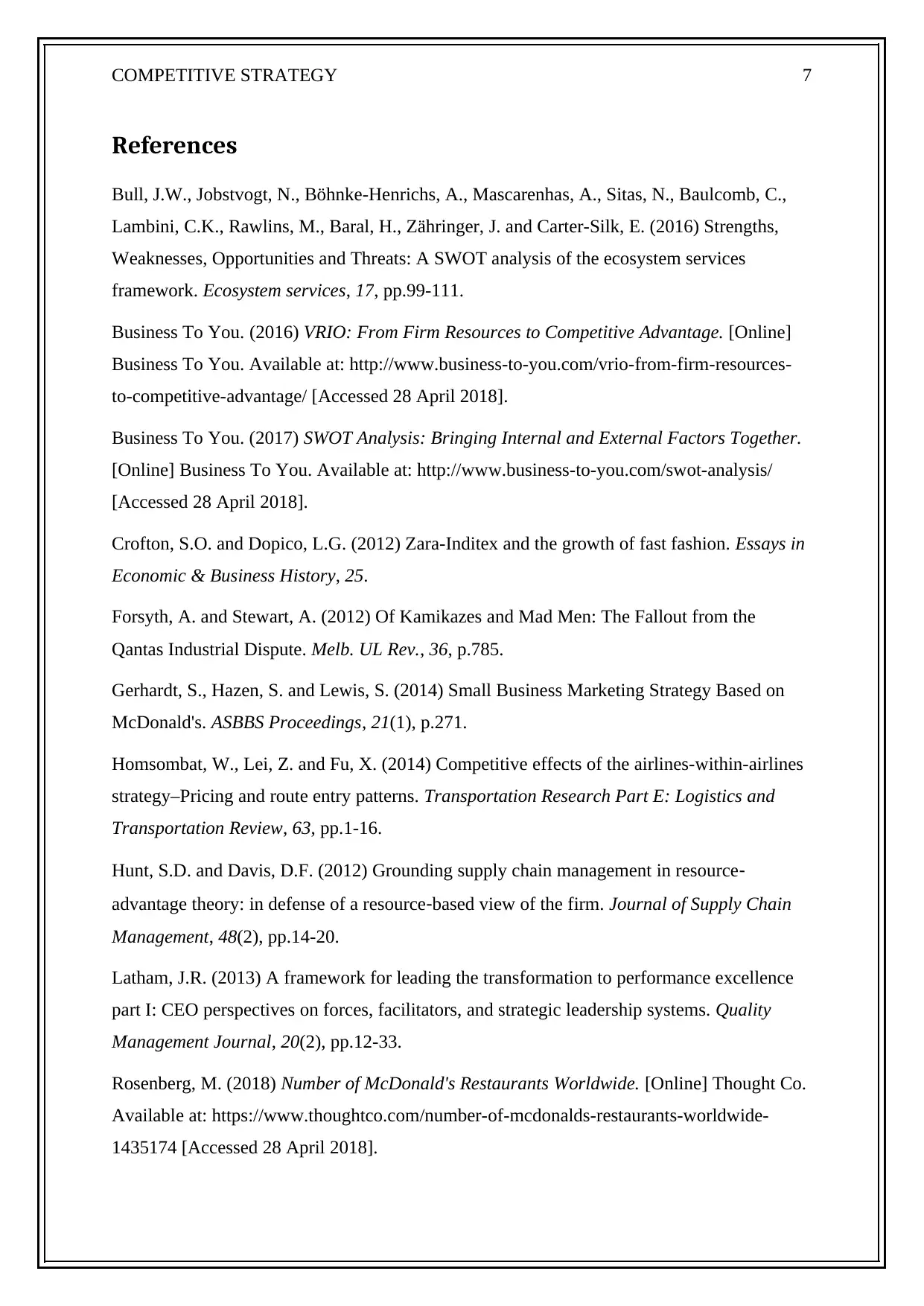
COMPETITIVE STRATEGY 7
References
Bull, J.W., Jobstvogt, N., Böhnke-Henrichs, A., Mascarenhas, A., Sitas, N., Baulcomb, C.,
Lambini, C.K., Rawlins, M., Baral, H., Zähringer, J. and Carter-Silk, E. (2016) Strengths,
Weaknesses, Opportunities and Threats: A SWOT analysis of the ecosystem services
framework. Ecosystem services, 17, pp.99-111.
Business To You. (2016) VRIO: From Firm Resources to Competitive Advantage. [Online]
Business To You. Available at: http://www.business-to-you.com/vrio-from-firm-resources-
to-competitive-advantage/ [Accessed 28 April 2018].
Business To You. (2017) SWOT Analysis: Bringing Internal and External Factors Together.
[Online] Business To You. Available at: http://www.business-to-you.com/swot-analysis/
[Accessed 28 April 2018].
Crofton, S.O. and Dopico, L.G. (2012) Zara-Inditex and the growth of fast fashion. Essays in
Economic & Business History, 25.
Forsyth, A. and Stewart, A. (2012) Of Kamikazes and Mad Men: The Fallout from the
Qantas Industrial Dispute. Melb. UL Rev., 36, p.785.
Gerhardt, S., Hazen, S. and Lewis, S. (2014) Small Business Marketing Strategy Based on
McDonald's. ASBBS Proceedings, 21(1), p.271.
Homsombat, W., Lei, Z. and Fu, X. (2014) Competitive effects of the airlines-within-airlines
strategy–Pricing and route entry patterns. Transportation Research Part E: Logistics and
Transportation Review, 63, pp.1-16.
Hunt, S.D. and Davis, D.F. (2012) Grounding supply chain management in resource‐
advantage theory: in defense of a resource‐based view of the firm. Journal of Supply Chain
Management, 48(2), pp.14-20.
Latham, J.R. (2013) A framework for leading the transformation to performance excellence
part I: CEO perspectives on forces, facilitators, and strategic leadership systems. Quality
Management Journal, 20(2), pp.12-33.
Rosenberg, M. (2018) Number of McDonald's Restaurants Worldwide. [Online] Thought Co.
Available at: https://www.thoughtco.com/number-of-mcdonalds-restaurants-worldwide-
1435174 [Accessed 28 April 2018].
References
Bull, J.W., Jobstvogt, N., Böhnke-Henrichs, A., Mascarenhas, A., Sitas, N., Baulcomb, C.,
Lambini, C.K., Rawlins, M., Baral, H., Zähringer, J. and Carter-Silk, E. (2016) Strengths,
Weaknesses, Opportunities and Threats: A SWOT analysis of the ecosystem services
framework. Ecosystem services, 17, pp.99-111.
Business To You. (2016) VRIO: From Firm Resources to Competitive Advantage. [Online]
Business To You. Available at: http://www.business-to-you.com/vrio-from-firm-resources-
to-competitive-advantage/ [Accessed 28 April 2018].
Business To You. (2017) SWOT Analysis: Bringing Internal and External Factors Together.
[Online] Business To You. Available at: http://www.business-to-you.com/swot-analysis/
[Accessed 28 April 2018].
Crofton, S.O. and Dopico, L.G. (2012) Zara-Inditex and the growth of fast fashion. Essays in
Economic & Business History, 25.
Forsyth, A. and Stewart, A. (2012) Of Kamikazes and Mad Men: The Fallout from the
Qantas Industrial Dispute. Melb. UL Rev., 36, p.785.
Gerhardt, S., Hazen, S. and Lewis, S. (2014) Small Business Marketing Strategy Based on
McDonald's. ASBBS Proceedings, 21(1), p.271.
Homsombat, W., Lei, Z. and Fu, X. (2014) Competitive effects of the airlines-within-airlines
strategy–Pricing and route entry patterns. Transportation Research Part E: Logistics and
Transportation Review, 63, pp.1-16.
Hunt, S.D. and Davis, D.F. (2012) Grounding supply chain management in resource‐
advantage theory: in defense of a resource‐based view of the firm. Journal of Supply Chain
Management, 48(2), pp.14-20.
Latham, J.R. (2013) A framework for leading the transformation to performance excellence
part I: CEO perspectives on forces, facilitators, and strategic leadership systems. Quality
Management Journal, 20(2), pp.12-33.
Rosenberg, M. (2018) Number of McDonald's Restaurants Worldwide. [Online] Thought Co.
Available at: https://www.thoughtco.com/number-of-mcdonalds-restaurants-worldwide-
1435174 [Accessed 28 April 2018].

COMPETITIVE STRATEGY 8
Visual Paradigm. (2018) What is Five Forces Analysis?. [Online]Visual Paradigm. Available
at: https://www.visual-paradigm.com/guide/strategic-analysis/what-is-five-forces-analysis/
[Accessed 28 April 2018].
Visual Paradigm. (2018) What is Five Forces Analysis?. [Online]Visual Paradigm. Available
at: https://www.visual-paradigm.com/guide/strategic-analysis/what-is-five-forces-analysis/
[Accessed 28 April 2018].
⊘ This is a preview!⊘
Do you want full access?
Subscribe today to unlock all pages.

Trusted by 1+ million students worldwide
1 out of 9
Related Documents
Your All-in-One AI-Powered Toolkit for Academic Success.
+13062052269
info@desklib.com
Available 24*7 on WhatsApp / Email
![[object Object]](/_next/static/media/star-bottom.7253800d.svg)
Unlock your academic potential
Copyright © 2020–2025 A2Z Services. All Rights Reserved. Developed and managed by ZUCOL.




